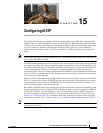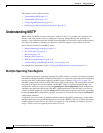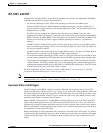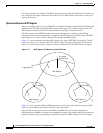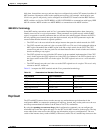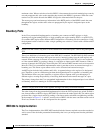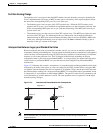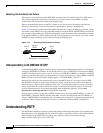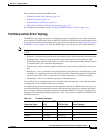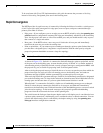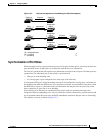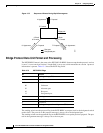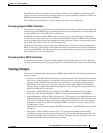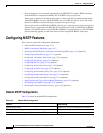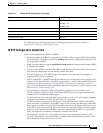
15-8
Cisco ME 3400 Ethernet Access Switch Software Configuration Guide
OL-9639-06
Chapter 15 Configuring MSTP
Understanding RSTP
Detecting Unidirectional Link Failure
This feature is not yet present in the IEEE MST standard, but it is included in this Cisco IOS release.
The software checks the consistency of the port role and state in the received BPDUs to detect
unidirectional link failures that could cause bridging loops.
When a designated port detects a conflict, it keeps its role, but reverts to discarding state because
disrupting connectivity in case of inconsistency is preferable to opening a bridging loop.
Figure 15-3 illustrates a unidirectional link failure that typically creates a bridging loop. Switch A is the
root switch, and its BPDUs are lost on the link leading to switch B. RSTP and MST BPDUs include the
role and state of the sending port. With this information, switch A can detect that switch B does not react
to the superior BPDUs it sends and that switch B is the designated, not root switch. As a result, switch
A blocks (or keeps blocking) its port, thus preventing the bridging loop.
Figure 15-3 Detecting Unidirectional Link Failure
Interoperability with IEEE 802.1D STP
A switch running MSTP supports a built-in protocol migration mechanism that enables it to interoperate
with legacy IEEE 802.1D switches. If this switch receives a legacy IEEE 802.1D configuration BPDU
(a BPDU with the protocol version set to 0), it sends only IEEE 802.1D BPDUs on that port. An MSTP
switch also can detect that a port is at the boundary of a region when it receives a legacy BPDU, an MSTP
BPDU (Version 3) associated with a different region, or an RSTP BPDU (Version 2).
However, the switch does not automatically revert to the MSTP mode if it no longer receives IEEE
802.1D BPDUs because it cannot detect whether the legacy switch has been removed from the link
unless the legacy switch is the designated switch. Also, a switch might continue to assign a boundary
role to a port when the switch to which this switch is connected has joined the region. To restart the
protocol migration process (force the renegotiation with neighboring switches), use the clear
spanning-tree detected-protocols privileged EXEC command.
If all the legacy switches on the link are RSTP switches, they can process MSTP BPDUs as if they are
RSTP BPDUs. Therefore, MSTP switches send either a Version 0 configuration and TCN BPDUs or
Version
3 MSTP BPDUs on a boundary port. A boundary port connects to a LAN, the designated switch
of which is either a single spanning-tree switch or a switch with a different MST configuration.
Understanding RSTP
The RSTP takes advantage of point-to-point wiring and provides rapid convergence of the spanning tree.
Reconfiguration of the spanning tree can occur in less than 1
second (in contrast to 50 seconds with the
default settings in the IEEE 802.1D spanning tree), which is critical for networks carrying
delay-sensitive traffic such as voice and video.
Inferior BPDU,
Designated + Learning bit set
Superior
BPDU
Switch
A
Switch
B
92722




